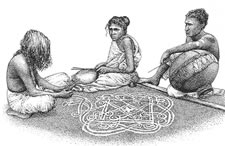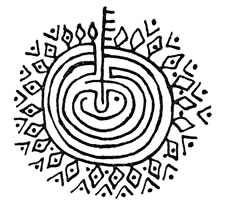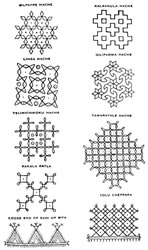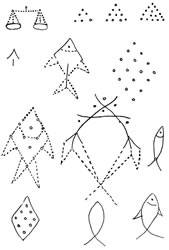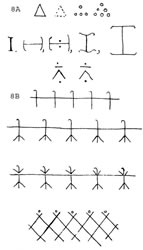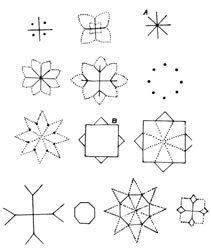India: Land of Eternal Ink
Article © 2009 Lars Krutak
For hundreds if not thousands of years,
India has maintained a rich cultural
heritage of tattooing tradition spanning the
entire length and breadth of the country.
From the dense, rain-soaked mountain jungles
of Arunachal Pradesh and Nagaland in the
northeast to the dry deserts of Kutch in
Gujarat on the Pakistan border in the far
west, tattoos not only served to beautify
the human body but to also carry it into the
afterlife.
|
|
Although the diversity of tattooing cultures in India is great, the
literature on the subject is surprisingly rare outside of obscure
university and governmental reports, not to mention early 20th century
census pamphlets buried in dusty archives and museum libraries. Aside
from these issues of access, the contemporary ethnographic record is
relatively weak on the art form itself. This can be attributed to the fact
that most of India's tattooed tribes have dwelled in remote hinterlands
until recently and have long been suppressed, forgotten, and/or
discriminated against for their refusal to discard "primitive" tribal
practices like tattooing that seemed uncivilized and unimportant in
comparison to more urban, modern, and sophisticated cultural lifestyles
in the cities. As one writer put it, "indigenous people are aware that
tattoos identity them as tribal, and hence they are seen as inferior." |
Nevertheless, I have managed to dig-up many of the old sources. I
have also had the opportunity to learn about tattooing from several Naga
informants on a recent trip to their homelands in the remote northeast.
What follows is a modest encyclopedic survey of traditional tattooing
practices in India past and present.
Antiquity
Tattoo (gudna, Hindi) in India is considered to be an ancient custom,
but just how old it is remains a mystery. One clue to its apparent
antiquity may be found in comparing petroglyph designs of labyrinths to
tattoos of similar design. For example, a recently discovered rock art
site tentatively dated to 2500 B.C. on a riverbank at Pansaimol, Goa
portrays a labyrinth cut into a stone (Fig. 1). Another labyrinth dated
to 1000 B.C. inscribed on a dolmen shrine at Padugla in the Nilgiri
Hills reveals a similar configuration (Fig. 2).
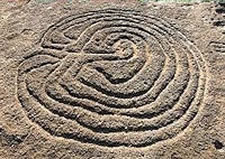 |
|
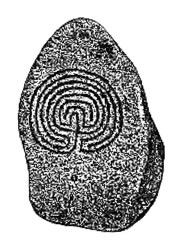 |
|
Fig. 1) Goa labyrinth |
|
Fig. 2) Nilgiri labyrinth.
|
In South India, magical devices called kolam resemble these
labyrinths (Figs. 3 & 4). Traditionally, they were created to serve two
magical functions. First they are associated with the protective,
fertile, and auspicious cobra deity (naga) and secondly they have an
apotropaic function, repelling or ensnaring demons. Kolam are made by
women who draw the designs freehand in lime, rice-powder, or some other
substance that trickles between their fingers like sand. The designs are
made at dawn, especially during the time of year when it is believed
that there are many demons and spirits about. Kolam are sinuous,
symmetrical figures seeming to consist of a single line, pursuing a
complex maze or path between rows and columns of dots. They are
typically placed near the threshold of the family home to provide its
inhabitants with protection and prosperity.
Not surprisingly, many South Indian tattoo designs worn around the
early 20th century were specifically derived from kolam patterns because
they were also believed to be protective in nature (Fig. 5). These
complex tattoos were a puzzle, since Yama, the God of death, and his
demon minions could not harm the tattooed since they could not solve the
puzzle that the tattoos presented. Why? Because kolam tattoos were a
maze with the idea that demons were drawn into the pattern, then lost,
and rendered powerless. At the same time, however, kolam markings were
also connected to other aspects of the afterlife. Among lower castes and
tribes, it was considered a necessity for women, and sometimes men, to
be tattooed in order to avoid punishment in the land of the dead:
because Yama's demons only devoured the unmarked. Kolam tattoos also
worked as a kind of map because they were believed to help guide the
dead person on their way to the land of the dead so that they would be
safely reunited with their deceased ancestors.
Common Tattoo Designs Among Women
Throughout India, tattoos are connected with magical ideas. From a
1902 article entitled "Notes on Female Tattoo Designs in India," it was
reported that a black dot symbolizing a mole on the forehead or chin was
believed to protect the bearer from the evil eye (Fig. 6.1). The mole or
tattooed dot was also considered an emblem of the Chandani,
corresponding to Venus, whose approach to the Moon, a personified male,
is a natural phenomenon held to represent the meeting of a loving pair.
The Moon is called Raktipati or Taraganapati, "King of the Night,"
"Husband of the Stars."
Rohini is his favourite wife, and she is represented thus •, while a
crescent shows the Moon. A dot between the horns of the crescent
represents the face of the Moon, which is often, however, drawn like the
human face in profile with another dot below it to represent his loving
consort. It is an emblem of conjugal happiness (Fig. 6.2).
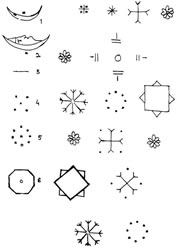 |
|
Figs. 6.1 - 6.6) Various tattoo patterns for women |
A line between the eyebrows represents the red powder or the ashes
applied to that spot as a protection from all evils (Fig. 6.3). It is
called angara, or vibhuti.
The Panch or five Pandavas (Fig. 6.4) who lived in conjugal happiness
- without disagreement - with one wife, represents domestic harmony
among brothers. This tattoo consists of four dots in a square penetrated
by one dot in the middle.
The nine planets or grahs (Fig. 6.5) are supposed to have great
influence over the destinies of mortals; and as a charm against
occasional evil influence a ring is worn containing the nine gems, such
as diamond, ruby, coral, topaz, pearl, emerald, sapphire, cat's-eye and
gomed or Burmese ruby. The ring is represented in the tattoo mark, eight
dots in a circle with one in the middle.
This eight-sided figure with a circle in the middle represents the
lotus (called phul in the tattoo mark) which is the seat or pedestal of
Lakshmi, the goddess of wealth. It also represents the whole universe,
and is drawn in different ways (Fig. 6.6).
Triangles are the mystic representations of the female power yoni.
Compare Sudrakamalakara's Rules of Worship for the Sudras. When a
Brahmin performs a religious ceremony in the house of a Sudra he draws a
triangle in water on the ground and not a swastika or a square, as he
would in the house of one of the "twice-borns." This triangle is called
yoni in the text mentioned above (Fig. 7).
This is the emblem of the fish. But what is a "fish" and why is it
lucky? Originally it represented the female power, the yoni.
The profession or caste of an individual is very often indicated by
tattoo marks, though it has not usually been intentionally included
among them. It will be interesting to find out whether ateran or uteran
(spindle) is tattooed by women of the spinning castes (Fig. 8A), who
were originally nomads, and are now mat-makers or rope-makers, still
unsettled in their habits.
The milkmaids of Krishna are thus represented (Fig. 8B).
These emblems will possibly show that the woman who bears them is a
milkmaid, Ahir or Goval by caste. It may be carefully noted that the
number of maids shown is always five. The mystic sign A shows the eight
directions, while B shows eight points of the compass produced by
placing two squares, one above the other, with their planes crossing
each other - the squares representing Heaven and Earth (Fig. 9).
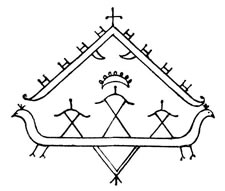 |
|
Fig. 10) Krishna's Crown tattoo |
The tattoo mark known as Kanhayya's mukat or crown is this (Fig. 10).
And there is no mistaking the caste of the woman using it. Although
the design is called mukat or "crown" only, it is the throne - the
peacock throne (mayur) of Krishna or Kanhayya. He is seated in the
center, with a crown over his head; to the left is his crowned wife,
Rukmini, and to the right his brother, Balaram. The women who bear this
emblem on their arms are Rajputs. Their great ambition, a brave husband,
a warrior on horse-back, is also portrayed.
The camel as a beast or burden was a very useful animal to caravans.
The Kasars, traders of copper and brass pots at Nasik, have two camels
on the pedestal of their goddess. Women with these marks will be found
to be Banjaras by caste, the dotted and linear delineation
distinguishing one tribe from another. Those with the dotted lines will
possibly be northerners and those with the heavy linear designs the
southerners. Of course, the Rabaris of Kutch in Gujarat also tattoo
symbols of the camel and they are nomadic traders (see section on
Gujarat below).
Another early article (1902) entitled "Note on Female Tattooing in
the Panjab [Punjab]" region reported that the madhavi (churn), the
ateran (spindle), the camel, the needle, the sieve, and the warrior on
horse-back clearly denote the castes of the women using them; but as
most of these designs have not been grouped according to castes, it is
difficult to discuss the question of identification fully. However, it
will be no surprise to find that the women are respectively: milk-maids,
spinners, traders or members of caravans, cobblers, farmers, and Rajputs.
These marks are the survivals of "obsolete totems", even if they be not
now recognized as such.
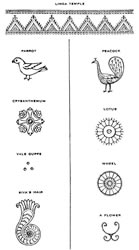 |
|
Fig. 11) Figurative tattoos |
The lotus, peacock, fish, triangle, and swastika are signs of luck,
and if tattooed on the left arms they are much more so. The chakra
(wheel), the stars, the pauchi and "Sita's kitchen" are protective
charms. Sita was protected by the enchanted circle (taboo) drawn around
her gumpha (hut, kitchen), and she was enjoined not to leave the latter
during her protector's absence. She disobeyed the order out of charity
towards Ravana, who was disguised as an ascetic and was thus carried off
by him.
The practice of tattooing a scorpion, a cobra, a bee or a spider has
its origin in sympathetic magic (Fig. 11) which is supposed to protect
people so marked. The parrot is a love-bird, and has special value as a
charm. But the spider deserves special mention, as it is credited with
the power of curing leprosy.
Other ethnic groups in India also believe in the "medicinal"
significance of tattooing. Mal Paharia women of Jharkhand confirmed that
tattooing kept the bodily organs healthy and helps them to function
properly. Muslim Maler women living in the Punjab were confident that
tattoo marks placed on the forehead promotes safe delivery in
child-birth.
The Dhelki Kharia of Jharkhand also had a rich tattooing tradition.
When a girl is old enough to walk, she is tattooed. In some cases the
tattooing is delayed until the tenth or eleventh year, but in any case
it must be completed before the girl is married. An omission to do so is
regarded as a social and religious offense, and has to be atoned for by
the sacrifice of a white fowl to Ponomosor (the Supreme Being and
Creator) and drinking a few drops of its sacrificial blood. Malar or
wandering Dhokar woman are the tattoo artists and they use a
three-pronged iron instrument to produce the tattoo markings. The tattoo
pigment is made of soot, preferably of charred behloa (Semicarpus
anacardium) wood. Mother's milk was mixed into the soot. After the
operation, the tattooist smears the puncture with turmeric paste diluted
in water. The tattooing is performed outside of the house, and after the
operation the tattooed girl was not permitted to enter the house until
she had been anointed with turmeric and oil all over her body and then
bathed. The touch of a Dhokar or Maler woman is a believed to cause
ceremonial pollution and requires lustration with turmeric and water.
As for the origin of the practice, some old Kharias of the Ranchi
District recount the following tradition: "In the course of their
migrations, before they had reached their present habitat, the Kharias
had encamped at the junction of two rivers and hoisted their flags
their. While they were crossing the river in canoes or boats, an alien
enemy took some of their men as captives, but they could not capture the
Kharia flag because the women-folk thrice repulsed them. It was in
memory of that sad event that their women began making tattoo marks on
the foreheads in the form of flags."
Notwithstanding there is a common belief across India that tattoo
marks migrate to Heaven with "the little entire man or woman (soul)"
inside the mortal frame. In other words, it is believed that if there is
anything that survives after death it is the tattoo marks, because the
soul is identified by them.
Next Page | 1
|
2 |
3 |
4 |
5
Museum photo gallery of the images
on this page may
be seen here.
|



